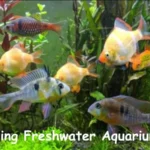fish farming
Nitrite levels in fish tank
The world of fishkeeping, while captivating and rewarding, presents a unique set of challenges. One of the most crucial aspects of maintaining a healthy aquarium environment is managing water quality. Among the various parameters that need constant monitoring, nitrite levels stand out as a significant indicator of potential danger to your aquatic companions. This essay of fishtankmagic.com delves into the intricate relationship between nitrite levels and fish health, exploring the sources of nitrite, the consequences of elevated levels, and effective strategies for managing and mitigating this potential threat.
Understanding Nitrite: The Silent Killer
Nitrite (NO2-) is a chemical compound that can accumulate in fish tanks due to the breakdown of ammonia (NH3) by beneficial bacteria. Ammonia is a toxic byproduct of fish waste, uneaten food, and decaying organic matter. The process of converting ammonia to nitrite is the first step in the nitrogen cycle, a natural biological process that occurs in aquariums. While nitrite is less toxic than ammonia, it can still pose a serious threat to fish health, especially when levels rise above safe limits.
The Nitrogen Cycle: A Delicate Balance
The nitrogen cycle is a fundamental process in any aquatic ecosystem, including your fish tank. It involves a series of steps where harmful substances like ammonia are converted into less harmful forms. This cycle relies on the presence of beneficial bacteria that live in the filter media and substrate of your aquarium.
Here’s a breakdown of the nitrogen cycle:
- Ammonia (NH3) Production: Fish excrete ammonia as a waste product, and it is also released from decaying organic matter like uneaten food and dead plants.
- Nitrification: Ammonia to Nitrite: Nitrifying bacteria, specifically Nitrosomonas species, convert ammonia into nitrite. This process requires oxygen and is crucial for reducing ammonia toxicity.
- Nitrification: Nitrite to Nitrate: Another group of nitrifying bacteria, Nitrobacter species, further oxidize nitrite into nitrate (NO3-). Nitrate is less toxic than ammonia or nitrite, but it can still accumulate in the tank.
- Nitrate Removal: Nitrate can be removed from the aquarium through water changes, plants, and specialized filter media.
The Danger of Elevated Nitrite Levels
When the nitrogen cycle is disrupted, nitrite levels can rise rapidly. This can happen due to various factors, including:
- Overfeeding: Excessive food leads to increased ammonia production, overwhelming the beneficial bacteria.
- Overstocking: Too many fish in a limited space generate more waste, exceeding the bacteria’s capacity to process it.
- New Tank Syndrome: Newly set up tanks lack the established colonies of beneficial bacteria needed to handle the ammonia load.
- Filter Malfunction: A faulty filter can reduce the surface area for bacteria growth and hinder the nitrification process.
- Sudden Temperature Changes: Extreme temperature fluctuations can disrupt the delicate balance of the nitrogen cycle, leading to nitrite spikes.
- High pH Levels: High pH levels can inhibit the growth of beneficial bacteria, leading to a build-up of nitrite.
The consequences of elevated nitrite levels can be severe:
- Reduced Oxygen Uptake: Nitrite binds to hemoglobin in fish blood, reducing its ability to carry oxygen. This can lead to suffocation and death.
- Stress and Immune Suppression: High nitrite levels stress fish, weakening their immune system and making them more susceptible to diseases.
- Gill Damage: Nitrite can irritate and damage fish gills, impairing their ability to breathe.
- Slow Growth and Development: Elevated nitrite levels can hinder fish growth and development, especially in young fish.
- Death: In severe cases, high nitrite levels can lead to rapid death.
Recognizing the Signs of Nitrite Toxicity
Early detection of nitrite toxicity is crucial for preventing serious consequences. Here are some common signs to watch for:
- Rapid breathing: Fish may exhibit rapid, labored breathing, gasping at the surface.
- Loss of appetite: Fish may refuse to eat or show a decreased interest in food.
- Lethargy: Fish may appear sluggish, inactive, and spend more time resting at the bottom of the tank.
- Color changes: Fish may lose their vibrant colors or develop a dull, faded appearance.
- Flaring gills: Fish may flare their gills in an attempt to increase oxygen uptake.
- Increased mucus production: Fish may produce excessive mucus around their gills and body.
- Red or swollen gills: Nitrite can cause inflammation and redness of the gills.
- Death: In severe cases, fish may die suddenly without any prior warning signs.
Testing for Nitrite levels in fish tank
Regularly testing your aquarium water for nitrite is essential for maintaining a healthy environment. There are several methods for testing nitrite levels, each with its own advantages and disadvantages:
- Liquid Test Kits: These kits are affordable and readily available at most pet stores. They typically involve adding a reagent to a water sample and comparing the color change to a color chart.
- Test Strips: Test strips are convenient and easy to use, but they may not be as accurate as liquid kits.
- Digital Meters: Digital meters provide more precise readings and can store data for future reference. However, they are more expensive than liquid kits or test strips.
Managing Nitrite Levels: A Proactive Approach
Preventing high nitrite levels is crucial for the well-being of your fish. Here are some effective strategies to manage and mitigate this potential threat:
- Regular Water Changes: Performing regular water changes is the most effective way to remove accumulated nitrite from your tank. Aim for 25-50% water changes weekly, depending on the size and stocking of your aquarium.
- Proper Filtration: A well-maintained filter is essential for removing ammonia and nitrite. Ensure your filter is appropriately sized for your tank and that the filter media is regularly cleaned or replaced.
- Avoid Overfeeding: Feed your fish only as much as they can consume within a few minutes. Excess food will decompose, contributing to ammonia and nitrite buildup.
- Control Stocking Density: Avoid overstocking your tank, as too many fish will generate more waste, overwhelming the beneficial bacteria.
- Monitor pH Levels: Maintain a stable pH level within the recommended range for your fish species. High pH can inhibit the growth of nitrifying bacteria.
- Use a Dechlorinator: Always use a dechlorinator to remove chlorine and chloramine from tap water before adding it to your tank. These chemicals can harm fish and disrupt the nitrogen cycle.
- Consider a Nitrite Remover: In cases of high nitrite levels, you can use a nitrite remover product to temporarily bind and remove nitrite from the water. However, these products are not a long-term solution and should be used in conjunction with other management strategies.
The Role of Live Plants
Live plants play a vital role in maintaining a healthy aquarium environment, including the control of nitrite levels. Plants absorb nitrate, the final product of the nitrogen cycle, reducing its accumulation in the water. This indirect effect helps to prevent nitrite levels from rising as the bacteria work to convert ammonia into nitrate.
Preventing Nitrite Spikes in New Tanks
Setting up a new tank can be a challenging experience, as the nitrogen cycle needs time to establish itself. Here are some tips to minimize nitrite spikes during the cycling process:
- Start with a Small Fish Load: Begin with a few fish and gradually increase the stocking density as the nitrogen cycle matures.
- Use a Starter Culture: Adding a starter culture of beneficial bacteria to your new tank can accelerate the cycling process.
- Monitor Nitrite Levels Closely: Test for nitrite levels daily during the cycling process and make adjustments as needed.
- Consider a Fish-in Cycle: This method involves adding a few hardy fish to the tank during the cycling process. The fish will produce ammonia, which will encourage the growth of beneficial bacteria. However, it’s crucial to monitor nitrite levels closely and be prepared to perform water changes if necessary.
Conclusion: A Balanced Approach to Nitrite Management
Maintaining healthy nitrite levels in your fish tank is essential for the well-being of your aquatic companions. By understanding the nitrogen cycle, recognizing the signs of nitrite toxicity, and implementing proactive management strategies, you can create a thriving environment for your fish. Remember, regular water changes, proper filtration, and responsible stocking practices are key to preventing nitrite spikes and ensuring the long-term health of your aquarium ecosystem.












